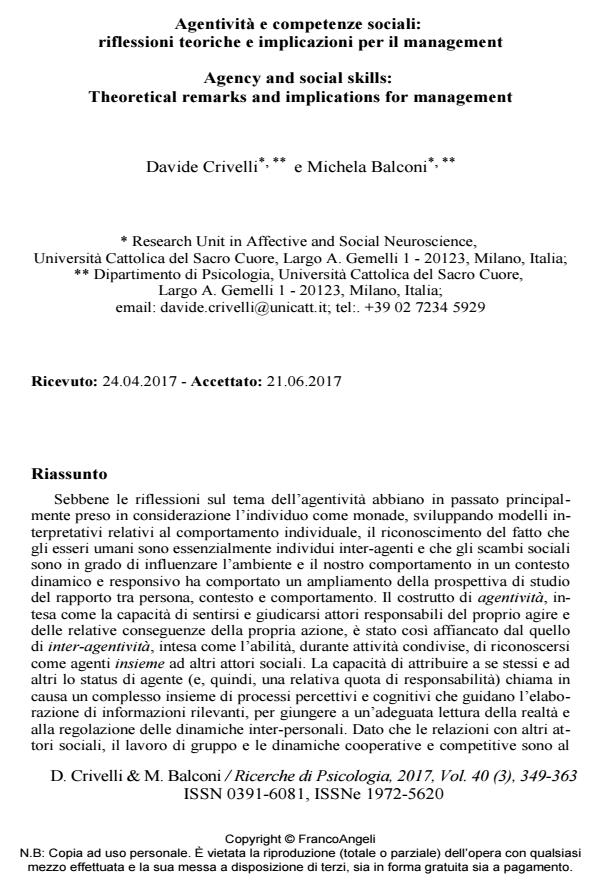Agentività e competenze sociali: riflessioni teoriche e implicazioni per il management
Titolo Rivista RICERCHE DI PSICOLOGIA
Autori/Curatori Davide Crivelli, Michela Balconi
Anno di pubblicazione 2017 Fascicolo 2017/3
Lingua Italiano Numero pagine 15 P. 349-363 Dimensione file 213 KB
DOI 10.3280/RIP2017-003006
Il DOI è il codice a barre della proprietà intellettuale: per saperne di più
clicca qui
Qui sotto puoi vedere in anteprima la prima pagina di questo articolo.
Se questo articolo ti interessa, lo puoi acquistare (e scaricare in formato pdf) seguendo le facili indicazioni per acquistare il download credit. Acquista Download Credits per scaricare questo Articolo in formato PDF

FrancoAngeli è membro della Publishers International Linking Association, Inc (PILA)associazione indipendente e non profit per facilitare (attraverso i servizi tecnologici implementati da CrossRef.org) l’accesso degli studiosi ai contenuti digitali nelle pubblicazioni professionali e scientifiche
Sebbene le riflessioni sul tema dell’agentività abbiano in passato principalmente preso in considerazione l’individuo come monade, sviluppando modelli interpretativi relativi al comportamento individuale, il riconoscimento del fatto che gli esseri umani sono essenzialmente individui inter-agenti e che gli scambi sociali sono in grado di influenzare l’ambiente e il nostro comportamento in un contesto dinamico e responsivo ha comportato un ampliamento della prospettiva di studio del rapporto tra persona, contesto e comportamento. Il costrutto di agentività, intesa come la capacità di sentirsi e giudicarsi attori responsabili del proprio agire e delle relative conseguenze della propria azione, è stato così affiancato dal quello di inter-agentività, intesa come l’abilità, durante attività condivise, di riconoscersi come agenti insieme ad altri attori sociali. La capacità di attribuire a se stessi e ad altri lo status di agente (e, quindi, una relativa quota di responsabilità) chiama in causa un complesso insieme di processi percettivi e cognitivi che guidano l’elaborazione di informazioni rilevanti, per giungere a un’adeguata lettura della realtà e alla regolazione delle dinamiche inter-personali. Dato che le relazioni con altri attori sociali, il lavoro di gruppo e le dinamiche cooperative e competitive sono al cuore delle attività di business e di management, risulta evidente la necessità di affinare la consapevolezza del nostro e dell’altrui comportamento, del modo in cui noi e i nostri interlocutori pianifichiamo e regoliamo il comportamento e di come siamo in grado di percepirci come agenti intenzionali all’interno di sistemi sociali complessi.
Parole chiave:Agentività, inter-agentività, competenze sociali, interazione sociale, neuromanagement.
- Le forme di scambio tra le generazioni nei contesti organizzativi: la transizione dei neolaureati al mondo del lavoro Silvio Ripamonti, Andreina Bruno, Laura Galuppo, Cesare Kaneklin, in RICERCHE DI PSICOLOGIA 3/2021 pp.1
DOI: 10.3280/rip2021oa12858 - The Use of Hyperscanning to Investigate the Role of Social, Affective, and Informative Gestures in Non-Verbal Communication. Electrophysiological (EEG) and Inter-Brain Connectivity Evidence Michela Balconi, Giulia Fronda, in Brain Sciences /2020 pp.29
DOI: 10.3390/brainsci10010029 - Affective, Social, and Informative Gestures Reproduction in Human Interaction: Hyperscanning and Brain Connectivity Michela Balconi, Giulia Fronda, Angela Bartolo, in Journal of Motor Behavior /2021 pp.296
DOI: 10.1080/00222895.2020.1774490 - What happens to information, situational cues, and individual strategies in decision-making? The contribution of latent decisional profiles in realistic decisions Davide Crivelli, Carlotta Acconito, Michela Balconi, in DECISION /2024 pp.57
DOI: 10.1007/s40622-024-00374-3 - Stress and neurocognitive efficiency in managerial contexts Davide Crivelli, Giulia Fronda, Irene Venturella, Michela Balconi, in International Journal of Workplace Health Management /2019 pp.42
DOI: 10.1108/IJWHM-07-2018-0095 - The “gift effect” on functional brain connectivity. Inter-brain synchronization when prosocial behavior is in action Michela Balconi, Giulia Fronda, in Scientific Reports 5394/2020
DOI: 10.1038/s41598-020-62421-0 - Physiology of Risk-Taking and Risk Management in Realistic Decision-Making Scenarios Davide Crivelli, Roberta A. Allegretta, Michela Balconi, in Psychological Reports 00332941241258919/2024
DOI: 10.1177/00332941241258919 - Neuro-Empowerment of Executive Functions in the Workplace: The Reason Why Michela Balconi, Laura Angioletti, Davide Crivelli, in Frontiers in Psychology 1519/2020
DOI: 10.3389/fpsyg.2020.01519
Davide Crivelli, Michela Balconi, Agentività e competenze sociali: riflessioni teoriche e implicazioni per il management in "RICERCHE DI PSICOLOGIA " 3/2017, pp 349-363, DOI: 10.3280/RIP2017-003006